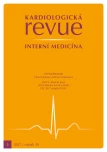Statin intolerance – finding practical solutions
Authors:
M. Šnejdrlová
Authors‘ workplace:
Centrum preventivní kardiologie, III. interní klinika 1. LF UK a VFN v Praze
Published in:
Kardiol Rev Int Med 2017, 19(3): 161-164
Overview
Statins significantly reduce cardiovascular morbidity and mortality, nevertheless, adequate use of statins to reach LDL-cholesterol target values may be limited by adverse symptoms that lead to discontinuation or termination of treatment. The most common cause of statin intolerance and non-adherence to treatment is statin-associated myopathy (SAM). SAM may be largely avoided by understanding the risk factors which increase the risk of SAM (rheumatological and neurological diseases, acute infections, hypothyroidism, old age, drug interactions and others), and, if they occur, by careful statin dose titration or by choice of statins with a lower risk of drug interactions. As there is neither a sufficiently sensitive and specific laboratory marker of SAM nor a specific examination method, a score system is recommended to assess the likelihood of SAM based on symptom characteristics (type of pain, association of the symptoms with statin therapy over time, including after withdrawal and re-challenge). In statin-intolerant patients, statins should be administered according to a modified regimen with a potential for increasing the dose up to a tolerated maximum.
Keywords:
statin intolerance – statin-associated myopathy – creatine kinase elevation – modified treatment regimen
Sources
1. Souhrnné údaje o dodávkách léčivých přípravků do lékáren a jiných zdravotnických zařízení dle léčivé látky a cesty podání za rok 2011. Státní ústav pro kontrolu léčiv. Dostupné na: http:/ / www.sukl.cz/ rok-2011-1.
2. Souhrnné údaje o dodávkách léčivých přípravků do lékáren a jiných zdravotnických zařízení dle léčivé látky a cesty podání za rok 2016. Státní ústav pro kontrolu léčiv. Dostupné na: http:/ / www.sukl.cz/ rok-2016-1.
3. Collins R, Reith C, Emberson J et al. Interpretation of the evidence for the efficacy and safety of statin therapy. Lancet 2016; 388(10059): 2532– 2561. doi: 10.1016/ S0140-6736(16)31357-5.
4. Rojas-Fernandez CH, Goldstein LB, Levey AI et al. The National Lipid Association’s Safety Task Force. An assessment by the Statin Cognitive Safety Task Force: 2014 update. J Clin Lipidol 2014; 8 (Suppl 3): S5– S16. doi: 10.1016/ j.jacl.2014.02.013.
5. Bays H, Cohen DE, Chalasani N et al. The National Lipid Association’s Safety Task Force. An assessment by the Statin Liver Safety Task Force: 2014 update. J Clin Lipidol 2014; 8 (Suppl 3): S47– S57. doi: 10.1016/ j.jacl.2014.02.011.
6. Laufs U, Filipiak KJ, Gouni-Berthold I et al. Practical aspects in the management of statin associated muscle symptoms (SAMS). Atheroscler Suppl 2017; 26: 45– 55. doi: 10.1016/ S1567-5688(17)30024-7.
7. Pella D, Gvozdjáková A, Lietava J et al. Myopatie asociovaná se statiny: klinické doporučení Slovenskej asociácie aterosklerózy a České společnosti pro aterosklerózu. AtheroRev 2016; 1(1): 7– 13.
8. Derry S, Loke YK. Risk of gastrointestinal haemorrhage with long term use of aspirin: meta-analysis. BMJ 2000; 231(7270): 1183– 1187.
9. Baigent C, Blackwell L, Emberson J et al. Cholesterol Treatment Trialist’s (CTT) Collaboration. Efficacy and safety of more intensive lowering of LDL cholesterol: a meta-analysis of data from 170,000 parti-cipants in 26 randomised trials. Lancet 2010; 376(9753): 1670– 1681. doi: 10.1016/ S0140-6736(10)61350-5.
10. Thompson PD, Clarkson P, Karas RH. Statin associated myopathy. JAMA 2003; 289(13): 1681– 1690. doi: 10.1001/ jama.289.13.1681
11. Doseděl M, Malý J, Vlček J. Lékové interakce statinů, jejich klinická závažnost a management. Remedia 2011; 21: 392– 397.
12. Bultas J. Vzájemné srovnání statinů z pohledu farmakologa. Remedia 2013; 23: 143– 150.
13. Prelle A, Tancredi L, Sciacco M et al. Retrospective study of a large population of patients with asymptomatic or minimally symptomatic raised serum creatine kinase levels. J Neurol 2002; 249(3): 305– 311.
14. Backes JM, Moriarty PM, Ruisinger JF et al. Effects of once weekly rosuvastatin among patients with a prior statin intolerance. Am J Cardiol 2007; 100(3): 554– 555. 10.1016/ j.amjcard.2007.03.059.
15. Gadarla M, Kearns AK, Thompson PD. Efficacy od rosuvastatin (5 mg and 10 mg) twice a week in patients intolerant to daily statins. Am J Cardiol 2008; 101(12):1747– 1748. doi: 10.1016/ j.amjcard.2008.02.061.
16. Štulc T, Beránková Š, Češka R. Praktický přístup ke statinové intoleranci. Vnitř Lék 2015; 61(11): 936– 941.
Labels
Paediatric cardiology Internal medicine Cardiac surgery CardiologyArticle was published in
Cardiology Review

2017 Issue 3
Most read in this issue
- Cardiovascular risk stratification and new serum lipid target levels
- SGLT2 inhibitors (gliflozins) antidiabetics, antihypertensives or drugs for heart failure?
- Statin intolerance – finding practical solutions
- Infective Endocarditis
